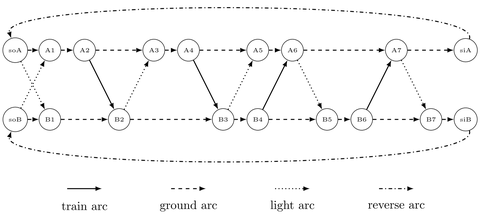Oct 08, 2025
New Publication on Mathematical Optimization in Railway Transport

Space-time network to represent a circulation planning problem
In collaboration between the Chair of Industrial Management at TU Dresden, Otto von Guericke University Magdeburg, and the University of Vienna, a new publication has appeared in the journal Public Transport. With contributions from Paul Päprer, Martin Scheffler, Udo Buscher and our former colleague Janis S. Neufeld the paper presents a comprehensive tutorial on the Rolling Stock Circulation Planning Problem – a key topic in tactical railway planning.
The research team compares two widely used graph-based modeling approaches – the connection-based network and the space-time network – and develops corresponding mathematical formulations for efficient train unit circulation planning. The study is based on real-world case studies provided by the Austrian Federal Railways (ÖBB), comprising 16 instances of varying size and structure.
The results show that for the fundamental circulation planning problem, the space-time network is considerably more efficient than the connection-based network, particularly for large and dense instances with many trips. Furthermore, multi-objective optimization reveals the trade-off between the number of vehicles and the costs of empty runs, while also highlighting differences between freight and passenger transport circulation plans.
The publication provides valuable methodological and practical insights for railway fleet management and establishes a solid foundation for future research in this field.
Reference:
Päprer, P., Joshi, K., Scheffler, M., Neufeld, J. S., Ehmke, J., Buscher, U. & Scherr, N. (2025). The rolling stock circulation planning problem: a tutorial with case study. Public Transport. https://doi.org/10.1007/s12469-025-00408-8
